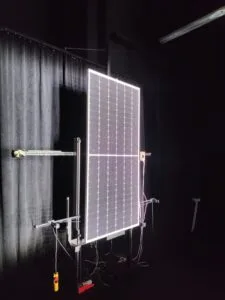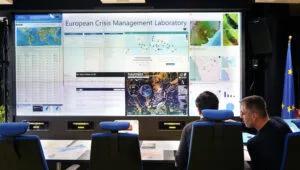From the correspondent in Ispra –Surrounded by thick brush and a few hundred meters from the shores of Lake Maggiore, hides one of the world’s most important research centres. It is the JRC, Joint Research Centre, a series of laboratories studying the dynamics of climate change and new tools to combat it. Local residents call the Lombard side of the lake the “lean shore” because the road system is more complicated, and the most beautiful villas are on the other side of Verbano. Yet it is in Ispra, in the province of Varese, where the JRC—a flagship in the field of research—is located. The Joint Research Centre is funded by the European Commission, and its inception dates back to 1957, when, with the signing of the Euratom Treaty, the European states decided to create joint research laboratories on nuclear energy. Even today, although disused, there is still a nuclear reactor in the JRC building complex in Ispra.
The Joint Research Center is different from all other laboratories in that, being funded by the EU, in addition to its classical research and innovation tasks, it also has the purpose of conveying the choices of European policymakers. The Ispra facility is not the only one; JRC also has laboratories in Geel in Belgium, Petten in the Netherlands, Karlsruhe in Germany, Seville in Spain, and the headquarters in Brussels. In total, only about 2,000 scientists work in the various locations of the Joint Research Center. The level of research is of high quality, as five per cent of JRC publications end up in the top one per cent of the world’s most cited research. The budget for the European research centres is around 730 million euros, of which 600 come directly from the Commission through funding from programs such as Horizon Europe, while the remainder comes from third parties, such as companies interested in testing their products with the sophisticated machinery in the research centres.
JRC labs to combat climate change
At Ispra, research is accompanied by pollution control and monitoring. One of the state-of-the-art laboratories is the WaterLab (which can be visited online). Thanks to its advanced equipment, it analyses water to determine whether it contains chemicals harmful to health or the environment. This laboratory provides reliable data and assessments that cover the entire scope of water-related issues-—from freshwater conservation and marine biodiversity to promoting sustainable water resource management.
The study of wastewater gives scientists a comprehensive view of the substances humans use in everyday life and#industrial and agricultural production. Pesticides rather than additives end up in wastewater and sewage treatment plants. Monitoring these waters makes it possible to understand in what proportions a specific substance is used and trace any polluting components. Not only that, all the substances that humans ingest are then disposed of by the body through excreta: studying wastewater even provides insight into the percentage of drug use in the population.
WaterLab has recently introduced Citizen science, or activities related to scientific research in which ordinary amateur citizens participate, into its data collection methods. Specifically, JRC researchers asked willing associations to collect water samples from rivers. Citizen science allowed them to study running waters in Costa Rica, where intensive banana cultivation threatens to ruin the river and marine ecosystem. After explaining the various procedures to the citizens, scientists from the JRC in Ispra provided kits to sample the water and send the vials to the laboratory. Actions like these, the researchers emphasise, are important both to raise awareness and because citizens feel that they are on the front lines of the fight to preserve the environment.

Another cutting-edge laboratory is ESTI, European Solar Test Installation (also this one can be visited online). This is a research centre, active since the 1970s, that has been testing and verifying the efficiency of solar panels. ESTI is at the forefront of setting European and global standards for photovoltaics. The machinery for testing solar panels is so advanced that private companies often come to this laboratory to test their products. Currently, the main challenge for photovoltaics, the scientists explain, is to find inexpensive materials, therefore usable on a large scale, that disperse as little energy as possible.
JRC researchers have also developed a tool accessible to all to estimate the output of a photovoltaic system. By entering the coordinates of the site and some data, such as the type of panels, it calculates the average monthly energy production, highlighting any critical issues, such as the presence of mountains that could reduce the hours of sun exposure. In addition, this tool makes it possible to calculate how much time the potential installers would return on the investment if they continued buying power instead of using solar energy.
A key laboratory for pollution monitoring is the Atmospheric Observatory. This laboratory measures gas and aerosol concentrations to study the interactions between the atmosphere, biosphere, and climate change. The data it provides are taken as a reference to verify the impact of emission reduction policies and to show major trends or changes in the atmosphere’s composition.
The JRC crisis management centre

The effects of climate change are also visible from the increasingly frequent extreme weather events. At the Joint Research Centre, for this reason, a crisis room (ECML) was built in which scientists monitor possible natural disasters. This laboratory was created to support countries in emergency management and to try to anticipate a disaster before it happens. Scientists here study earthquakes, fires, floods, and landslides to limit the damage they may cause to the population.
The effectiveness of this laboratory is mainly due to the use of the Copernicus program satellites. A key step in crisis management that scientists have been able to achieve is the mapping of all buildings in the world. This map, obtained through satellite imagery, is critical for understanding what measures to use in an emergency on a given territory and for understanding the building density that can play a critical role in the event of a natural disaster. The result of this research has surprising implications: buildings in Warsaw, which has a population of 3 million, occupy an area not much smaller than Beijing, where 22 million live.
The crisis management laboratory also aims to support national agencies in emergency management. A singular case that demonstrates the validity of this centre is the disaster that occurred after the dam in Nova Kachovka, Ukraine, was blown up. The ECML studies, among other things, how an attack on critical infrastructure can cause damage and disaster. The scenario of the destruction of the dam on the Dnipro River had been studied, and JRC’s prediction proved so accurate that it was taken as an example to develop new, even more accurate models.
English version by the Translation Service of Withub



